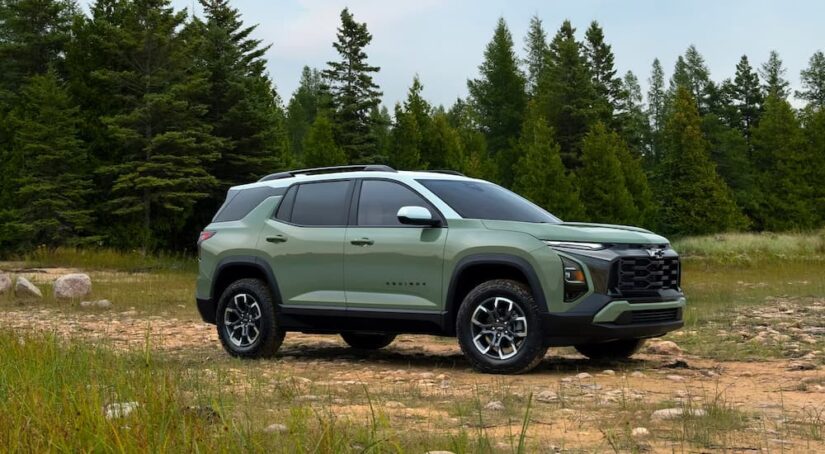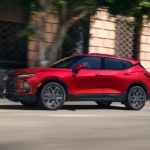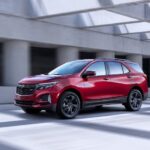Buying the right crossover SUV can be a challenge. You want a vehicle that’s not too big or too small while giving you the right combination of on-road smoothness, off-road capability, and useful features. Even those loyal to a single nameplate will find many options they have to sort through.
When you visit a Chevy dealer to find a crossover SUV, there’s a good chance the Equinox and Blazer will catch your eye. The Chevy Equinox was introduced in 2004 and has become one of Chevy’s best-selling vehicles, regularly topping 200,000 and even 300,000 units a year in the US. Originally a midsize crossover, it was redesigned as a compact crossover in 2018. It was replaced in the midsize segment by the Chevy Blazer, marking the return of a nameplate that captivated car buyers from 1969 to the early 2000s.
Both SUVs are high-quality vehicles that will get you where you need to go—but should the Equinox or Blazer sit in your driveway? I decided to take a closer look at the Equinox and Blazer to see which Chevy crossover SUV is right for you. Seeing as the Equinox is getting a refresh for the 2025 model year, it’s an excellent time to see what these SUVs offer to crossover and Chevy enthusiasts.
Powertrain Options
The powertrain is the heartbeat of a vehicle, making it a good place to start this head-to-head. The new Chevy Equinox will keep the same 1.5L turbocharged inline-four engine as its predecessor. This powerplant produces 175 hp and 203 lb-ft. of torque—enough to get around the city but not something that will make you feel a rush on highways or trails. On the plus side, the Equinox has excellent fuel economy for its segment. The standard front-wheel drive (FWD) Equinox gets an EPA-estimated 27 combined MPG, while the all-wheel drive (AWD) variant gets a combined 26 MPG. Beginning with the 2025 model, the six-speed automatic transmission switches to an eight-speed on the AWD and a continuously variable transmission on the FWD for a little more pop when you accelerate.
If you’re looking for more power to support an adrenaline rush, the Chevrolet Blazer is your crossover. Base Blazer models use a 2.0L turbo inline-four, which provides 228 hp and 258 lb-ft of torque. For an even bigger surge, the 2LT, Premier, and RS trims are available with a 3.6L V6 engine that pumps things up to 308 hp and 270 lb-ft of torque, which lets you go from 0-60 mph in just over six seconds. Both engines use a nine-speed automatic transmission, and AWD is the standard, with FWD being optional. Fuel mileage is admittedly lower, maxing out at an EPA-estimated 25 combined MPG with FWD. If you’re buying the Blazer mainly for the added power and acceleration, I’m guessing fuel economy isn’t a primary consideration.
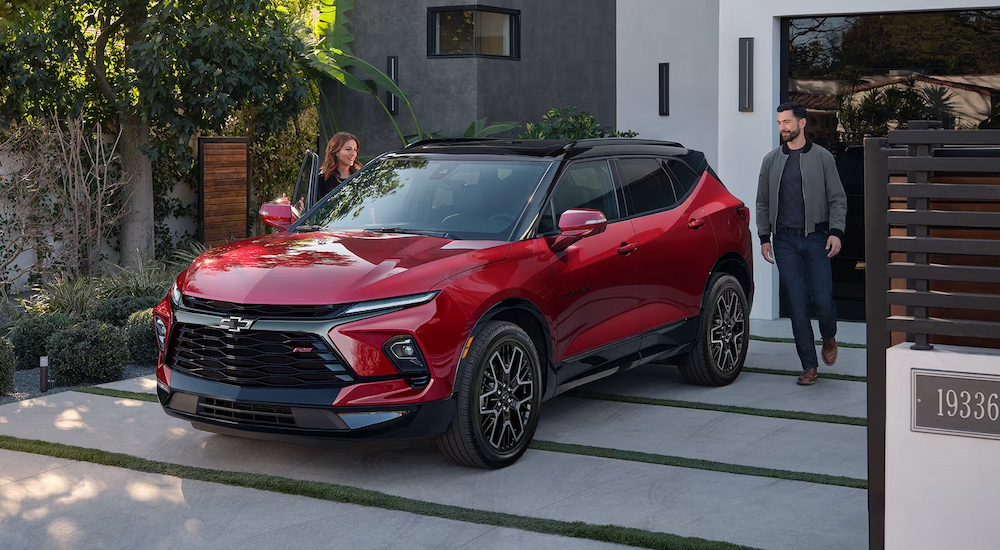
Suspension and Other Exterior Features
Up next is how these crossovers perform and look. I’ll begin with the shared features between the two SUVs. These include four-wheel disc brakes with ABS for safe stopping, selectable drive modes to change how the vehicle responds to certain conditions, and Automatic Stop/Start that can shut the engine off when stopped to save gas. They’re much-appreciated options that can be used pretty much anywhere.
Now for the differences. The refreshed Chevy Equinox is equipped with a MacPherson front suspension and a four-link rear suspension that gives you a smoother riding experience. The Automatic Vehicle Hold feature lets you take your foot off the brake pedal after stopping without the vehicle starting to roll, which is useful in busy city traffic. A power liftgate is available, along with automatic windshield wipers, solar-absorbing windows, splash guards, and a power sunroof. Other noteworthy characteristics include standard roof rails on most models, hidden turn-down exhaust tips, heated side mirrors, and an available trailer hitch.
All that is certainly appreciated by the average driver. Just like the engine is bigger on the Blazer, so are the performance and style. The fully independent, pre-tuned “Ride and Handling” suspension harnesses the SUV’s extra horsepower and size for a comfortable ride. Additional trailering equipment is available for towing boats and small campers, including a Hitch View Camera, Sway Control, Hitch Guidance software, and a heavy-duty cooling system. The RS trim gets a twin-clutch AWD system that can send power independently to each rear wheel, improving traction and performance on all terrains. You also get standard automatic on/off headlights and can add a variety of appearance packages for a customized look. The Blazer even has a dual-outlet exhaust with rectangular or circular tips for a visual pop.
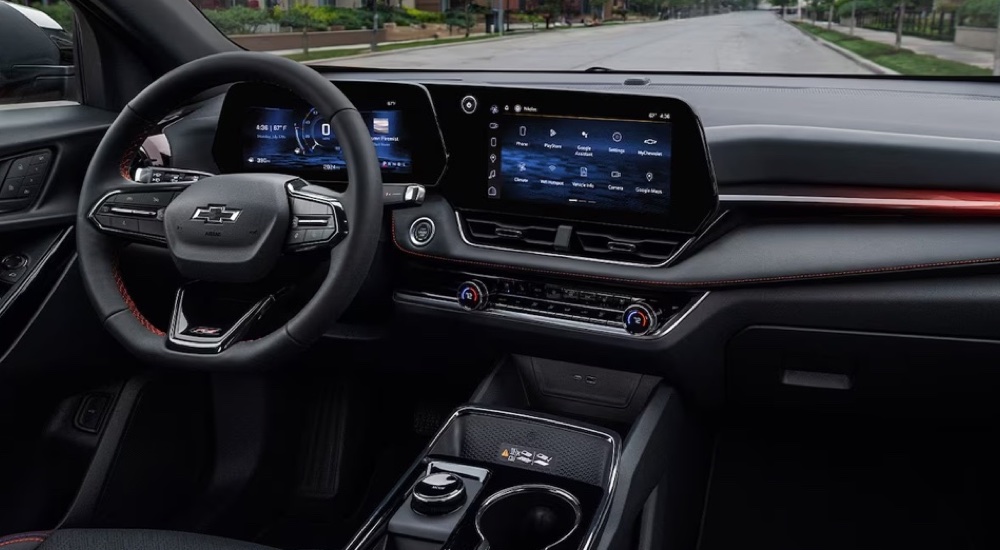
A Closer Look at Each Model’s Interiors
It’s time to hop inside these five-seat SUVs to see what they’re like on a drive. Despite the Blazer being eight inches longer, 1.4 inches taller, and 1.8 inches wider than the next-generation Equinox, it barely ekes out the victory in cargo space, maxing out at 64.2 cu.ft. of storage area versus the Equinox’s 63.5 cu.ft. This is partly because the larger engine requires more space and partly because the Blazer has a more spacious seating area. Headroom and legroom are basically identical, but the Blazer offers considerably more shoulder and hip room to increase comfort. An eight-way power driver’s seat is standard on all Blazer models, while some Equinox models still use a six-way manual seat.
The rest of the interior layout is similar between the SUVs. Premium carpeted floor mats and heated front seats are standard, while all-weather mats are available. The Rear Seat Reminder system alerts drivers to check the back seats so no people, pets, or objects are left behind. A tiltable and telescoping steering column allows precision adjustments. The Blazer has a standard digital compass for finding your way when mapping software and GPS aren’t available. Meanwhile, the Equinox gets front seatback pockets for storage.
As for technology, the new Equinox receives considerable upgrades. Beginning with the 2025 model year, all Equinox SUVs have an 11.3-inch infotainment touchscreen with Google built-in automotive services, plus an 11-inch digital instrument cluster (Previous model years had a 7- or 8-inch screen). They also get wireless Android Auto and Apple CarPlay, 5G connectivity, Wi-Fi hotspot capability, front and rear USB ports, a six-speaker sound system with Active Noise Cancellation to reduce road noise, a full driver assistance safety suite, and wireless charging on certain models. The Blazer’s screens are slightly smaller at 10.2 inches and don’t include Google or 5G. Chevy tries to compensate for this by adding standard Bluetooth wireless connectivity, an optional Bose eight-speaker system, and a three-year subscription to OnStar.
The Verdict
So, which SUV should be on your wishlist? Based on my analysis, the Chevy Equinox is for people who want a practical everyday crossover, though the Activ trim does add all-terrain tires for adventuring. The bigger screens and integrated 5G play into this, putting high-speed data and entertainment at your fingertips. If you’re into thrill-seeking, the Chevy Blazer will be more your cup of tea. This midsize SUV has more power, better suspension, superior towing capabilities, and adventure-specific features. In a Blazer, you can enjoy moderate off-roading and big trips without sacrificing over-the-road performance. By thinking about your driving habits and goals, you can select the right Chevy crossover SUV to meet them. There’s no replacement for a test drive, of course, but keep this guide in mind as you steer toward your new vehicle.
